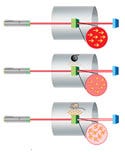Sensor Gets to the Heart of Monitoring
January 1, 2008
R&D DIGEST
|
(click to enlarge) |
A low-power, noninvasive sensor that detects magnetic fields may be a low-cost way to monitor the heart and brain. The chip-scale magnetometer, created at the National Institute of Standards and Technology (NIST; Boulder, CO), has potential uses in fetal heart observation and epileptic patients.
In biomedical applications, magnetic sensors monitor the fields generated by the heart or brain. As the heart pumps blood, electrical signals that produce magnetic fields run into the organ to ensure proper heart function. When a sensor is placed near the heart, it monitors those magnetic fields.
Researchers used a previous version of their sensor to measure the magnetic fields in a mouse heart. The device might also be able to sense weak magnetic fields from the brain, which are about a factor of a thousandth smaller than the fields that the heart produces.
There are many ways to sense magnetic fields, says John Kitching, a physicist at NIST and the principal investigator. The gold standard for magnetometers is superconducting quantum interference devices, or SQUIDs. Although SQUIDs have good sensitivity, they're large and often run on a cumbersome cryogenic system because they must be cooled down to very low temperatures. Small and inexpensive magnetoresistor sensors can also be used to detect magnetic fields, but the devices aren't very sensitive.
NIST's prototype merges the useful characteristics of a SQUID and a magnetoresistor sensor. It reaches the SQUID's high sensitivity levels but is small and could potentially provide low power dissipation. It is nearly 1000 times more sensitive than NIST's original version and should be able to see signals clearly. The device design is based on a chip-scale atomic clock developed at NIST.
According to Kitching, NIST's initial prototype had a sensitivity of 40 picotesla (pT) per root hertz (rtHz), and the second generation, developed almost a year ago, had a sensitivity of 6 pT/rtHz. The most recent instrument has a sensitivity of 70 fT/rtHz. A tesla is the unit of measurement that defines a magnetic field's strength; a femtotesla is one quadrillionth of a tesla.
Implemented on a tabletop, the system's main components are an infrared laser, a vapor cell that contains atoms, and a photodetector. The photodetector is a solar cell that detects the amount of power moving through the device. Approximately the size of a grain of rice, the vapor cell contains about 100 billion atoms of rubidium, which is sensitive to magnetic fields.
The laser sits a few feet away from the vapor cell and shines onto the atoms, causing them to point in the laser beam's direction. When a magnetic field is present, the atoms become disoriented and no longer point in that direction. This causes a change in the transmission of light that moves through the cell. A magnetic field can be detected just by looking at the transmitted light.
In addition to heart monitoring, the device has potential in the field of magnetoencephalography (MEG), which measures magnetic fields created by electrical activity in the brain. This could be useful in epilepsy research and treatment. Epilepsy is caused by abnormal brain activity, and magnetic sensor could localize where activity is happening during a seizure. Pinpointing activity would help surgeons plan a procedure based on where the activity is occurring.
In order to use the sensor for MEG, Kitching suggests exploring alternative device designs that place the magnetic components in a remote location with respect to the vapor cell. Because brain fields are weak, reducing other magnetic factors in the area would be helpful. NIST researchers are also looking into creating a portable MEG helmet that would record brain activity prior to and during a seizure.
The next step is to reduce the device's size. “Our work focuses on developing the physics assembly, which is the core of the instrument and the most high risk in terms of development,” says Kitching. “It has to be integrated with some electronics to actually be able to run.” However, he doesn't anticipate any problems in further miniaturizing the sensitive device and incorporating it into a package that is a few cubic millimeters in volume.
Details about NIST's device were published in the November issue of the journal Nature Photonics.
Copyright ©2008 Medical Device & Diagnostic Industry
About the Author(s)
You May Also Like



